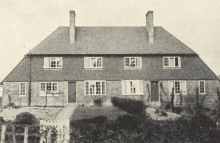
Francis Oliver Marchant was born in Darenth, Kent, England on 5 June 1887. He was the first pupil of Ernest Newton (1856-1922) and subsequently was his assistant. In the years immediately after World War One Marchant worked in China, and was employed by Hemmings & Berkely in Hankow. By 1922 he had returned to England and was practising as an architect in London. Marchant mainly worked as a designer of houses in south London. By 1937 he had settled in Eastbourne, East Sussex and worked on local authority housing schemes in Kent and Sussex. He some times worked on housing projects with Sir Giles Gilbert Scott (1880-1960). Following World War Two he moved back to London.
A photograph of a house in Tenterden, Kent designed by Marchant is illustrated in The Book of the Modern House, edited by Patrick Abercrombie (1939 p. 38)
Marchant was elected an Assaociate of the Royal Institute of British Architects (ARIBA) in 1919 and a Fellow of the Royal Institute of British Architects FRIBA) in 1939.
He served with distinction in the Army in World War One and was awarded the Military Cross (MC). He reached the rank of Major, a title he used when practising as an architect as late as 1939.
Marchant's address was given as Lower House Farm, Colwall, Malvern, Herefordshire (1911); 7c, Grove End House, St. John's Wood Road, London in 1923; 2 Bedford Square, London in 1926; 10 Taviton Street, Gordon Square, London in 1930; Broomfield Blackboys, Uckfield, East Sussex in 1935; 63 Vicarage Road, Eastbourne, Sussex 1937 and 1939; 12 Argyle Mansions, Addison Bridge, Fulham, London in 1955 and 1958; and 23 Westgate Terrace, London in 1961. He died at Charring Cross Hospital, London on 5 July 1961.
Numerous private house in South East London and in Kent and Sussex;, Structural repairs to St. Mary & St. Nicholas, Etchingham, East Sussex (1937-38)